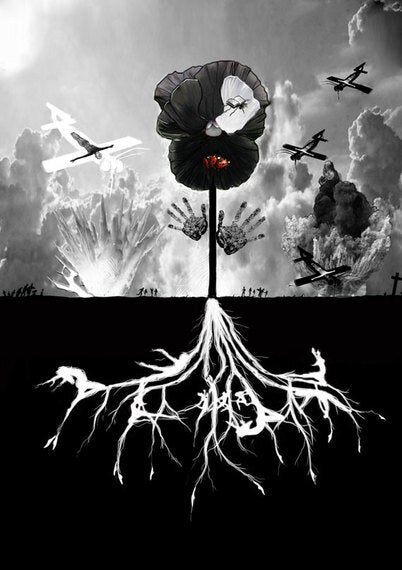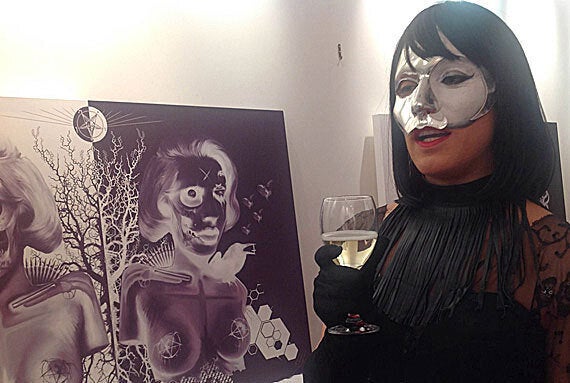"I grew up with no role models," says Xxxora, as she flicks her black hair from her face.
"I've had to live in the binary. Now I only ever dress in black and white. It's my political statement. I do wear a silver mask. It makes me feel comfortable, safer, confident, I feel very vulnerable not having anything."
I describe Xxxora as 'she' and 'her' because it's simpler for me to do that. I've not been taught any other way and I'm not sure how to explain her accurately with the appropriate personal pronoun. This is the loophole in the gender 'binary' that treats all people as either male or female.
The 33-year-old artist looks, acts and dresses like a woman, but she knows she is more than that, being one of the 30,000 plus people in the UK born with ambiguous sex organs - male and female.
Raised as a boy by her working-class Spanish parents she grew up in Ealing, West London, consciously uncomfortable wearing male clothes. She went through art school at Goldsmith's College living as a man but later switched to a female persona, with which she more readily identifies.

Artist Xxxora is campaigning for the human rights of hermaphrodites
Now comfortable in herself Xxxora is in a stable relationship for the first time and is using her art to further inform and campaign on rights for 'unisex' people (the newly preferred term).
She no longer refers to her previous male identity, but rejects being described as either male or female - and wants the government to recognise her as both, with a legal addition to official gender categories.
Exhibiting over the past two years, her art work focuses on androgyny and naturally occurring hermaphroditic species - flora and fauna, which she uses to bring greater awareness and promote more debate on the topic.
Her latest show, the Captured Hermaphrodite, finished on Friday in the City of London and she was last week nominated for an emerging talent prize at the Southwark Art Awards.
"Most people do not realise quite the number of hermaphroditic species that occur naturally in the world and so this show is an entertaining yet also an educative experience," she says.

A recent artwork by Xxxora titled 'The Pansy'
"My physical aesthetic and my work is always in black and white.
"I will continue to enforce these unnecessary binary limitations on my work and appearance until the UK recognises the hermaphrodite in law and adds a third box to the category of gender in passports, following in the footsteps of countries like Australia, New Zealand and India.
"Evidence that the hermaphrodite exists is obviously overwhelmingly supported by science yet our society and its laws still ignore people like me."
And she is not alone in wanting change.
There is a growing recognition of the inadequate and often damaging treatment given to children born with both male and female sexual organs.
The medical community has long regarded hermaphrodism as something that can be 'solved' (Disorders of Sex Development - DSD) by corrective surgery or by picking what gender to raise a child based on the extent of their physical development. This is usually decided not long after birth and within the first 18 months of a child's life.
Damagingly, it doesn't take into account a person's natural sexual inclination, which does not manifest until much later. And so many unisex children, like Xxxora, are raised as a gender they don't identify with, leading to confusion, depression and feelings of shame.
To further complicate the situation it has been accepted medical practice in some quarters to keep the truth from the individual and sometimes the parents.
Dr Jay Hayes-Light, of the UK Intersex Association, says one in 2,000 people worldwide are born with 'ambiguous' sexual organs, making it a more common phenomenon than cystic fibrosis or autism.
He adds: "Currently, the UK does not recognise gender markers other than 'male' or 'female' on official documents such as passports although it is likely that this will change in the future.
"Those intersex people who identify as neither male nor female are in the minority in the UK.
"Most intersex people do have a distinct gender identity as either male or female (irrespective of anatomy). What is important however, is that the government acknowledge that some do reject binary sex labels."
Back in 2004 Dr Naomi O'Keefe, a psychologist from Argosy University in California, testifying on human rights violations against hermaphrodites, noted that much psychological harm was done to intersex people because society continued to keep it hidden behind a veil of secrecy and shame.
Meanwhile, Zwischengeschlect.org, a human rights advocacy group based in Germany, has attacked what it calls the extermination of hermaphrodites through corrective surgery, arbitrary decisions made at birth about the most appropriate sex to raise children and an unwillingness to speak about the issue.
It noted: "By the end of the 20th Century, after 50 years of systematic surgical and hormonal 'corrections' and 'repairs', as a species hermaphrodites are virtually extinct, both in real life and in public perception."
The group advocates respecting the physical integrity of unisex people and the self-determination of children born with atypical genitals.
The term hermaphrodite derives from the mythological Hermaphroditus, the son of Greek gods Hermes and Aphrodite, who was fused with the nymph Salmacis.
While there are lesser manifestations of it, 'true' hermaphrodites have a completely different chromosomal make-up to men and women with their karyotype having both XX and XY chromosome pairs.
In her art Xxxora (her pseudonym a reference to chromosomes not porn) also focuses on human subjects that are androgynous, either by nature or deliberately. Stars like David Bowie, Marilyn Manson and Lady Gaga or women political leaders who take on male traits: Margaret Thatcher, Golda Meir, Hillary Clinton.

The artist at her pop-up exhibition in the City of London
"These for me are the only role models I could even grasp," she says. "People who displayed androgyny. The question is did these people display androgyny viscerally, are they innately androgynous, or did they manipulate their gender variance for other reasons.
"Performers like Lady Gaga have used that androgyny to further their careers."
Other works by Xxxora include an oak tree (another hermaphrodite species) intertwined with bodies. There is a recurrent theme of torture in her art that draws on Hieronymus Bosch and Francis Bacon. Clerical liturgy is represented as insects, irritants attacking the populace - a comment on the church's unwillingness to even acknowledge unisex people.
These images convey both optimism and pain, and while Xxxora is outwardly well-spoken and quite flamboyant (recently disrupting a Damien Hirst launch at Blain Southern's Candy exhibition in Hanover Square by leaping into a large pile of sweets - an untitled work by Felix Gonzales-Torres) there is an awkward shyness there at times that hints at her struggles.
She intends to create works for the rest of her life on the theme, taking as her inspiration the thousands of naturally occurring dual sex species.
"When I was younger I was put into a boys school," she says. "I had predominantly male organs so therefore the decision was made that I had to live like that, but it's not my instinct in any way shape or form. Sexually, I feel completely feminine.
"My works show the slaughterhouse of being a hermaphrodite today."